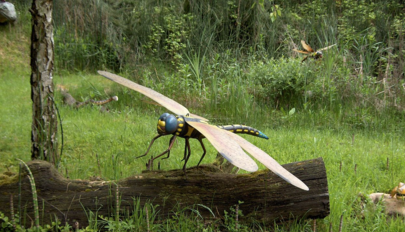Frightening Prehistoric Animals

How terrifying is this prehistoric flying insect?
Just as is true today, the ecosystems of the past were populated with animals ranging from adorable to hideous. Today we have many animals that are potentially extremely dangerous to your average human, from giant predators like lions, sharks, and crocodiles to subtle killers like poisonous snakes, insects, and jellyfish. However, these are familiar creatures, and the precautions necessary to avoid them are well known. By comparison, the dangerous species revealed by paleontology are not only more deadly but also more alien and grotesque. The diversity of these species is also quite staggering, and there is a prehistoric monster for every taste and each phobia.
Dunkleosteus: The primordial oceans were home to a vast area of sea monsters, but there are few as unusual and grotesque as the dunkleosteus. This armor plated fish lived during the Devonian, around 400 million years ago. They were the top predators of their time, reaching length of around 35 feet long at maximum. That is twice as long as the average Great White Shark (17 feet) and noticeably larger than the Orca (28 feet). Dunkleosteus’s most striking feature was its armored skull, over which there is only a thin layer of skin. This gives it a nightmarish face that grimaces constantly, almost like a human skull. Instead of teeth it had giant bone cleavers growing out of its skull, which made its bite force once of the strongest known. It would have been more that capable of biting through the hull of a sailboat, and its armor meant it faced no retaliation from lesser predators. This means if it were alive today, there would be no marine animal capable of threatening an adult dunkleosteus.
Meganeura: Although today’s insects are far smaller than a human, they still frighten and disgust most people due not only to their painful stings, bites, and poisons, but also their bizarre and disgusting chitinous bodies. Most of us take great care to avoid looking at the too closely, but that would be impossible with meganeura, a dragonfly the size of an eagle. This monstrous creature lived during carboniferous, about 320 million years ago. At that time the planet’s atmosphere had three times the oxygen content, which fueled the massive growth of insects and other arthropods from millipedes as long as a fully grown man to spiders and scorpions the size of watermelons. At the time amphibians were large but aquatic and reptiles were still small creatures, so meganeura was the apex predator in its environment. To see a swarm of them darkening the sky must have been one of the most breathtaking and horrifying sights nature has ever produced.
Therizinosaurus: Therizinosaurus may look like little more that an outlandish, giant turkey, but any african game warden worth his pith helmet knows that there is no animal more dangerous that a large herbivore. As herbivores go, therizinosaurus shows the signs of being one of the most dangerous of all. This strange dinosaur was the size of a Tyrannosaurus Rex (45 feet long), and was possessed of a truly unique natural weapon: scything talons up to seven feet long. Mounted on arms like tree trunks, these claws were capable of bone shattering blows with minimal effort. This fact is demonstrated in the fossils of predatory dinosaurs that attempted to prey upon it. Of course, these claws were only intended for defense, but like the modern hippo and rhino the term defense was more likely applied to defense of territory. If getting between a hippo and its water is one of the most dangerous things you can do today, then standing between a mother therizinosaur and her eggs would have been suicidal
Austroraptor: The “Velociraptor” (actually this creature more closely resembles the real life deinonychus) of Jurassic park fame cemented these lightning fast predators as one of the most dangerous predators ever in the eyes of pop culture, and this image is in truth well deserved. Austroraptor is that animal times two. The largest “raptor” dinosaur (dromaeosaur), measuring twenty feet long with the weight of a polar bear and almost twice the height of a human when fully upright. It has all the classic traits that make dromaeosaurs lethal predators: extreme speed and agility, the intelligence to coordinate with a pack, and most important the “killer claw” on its toe which hooked into the flesh of a prey animal and use a massive kicking motion to rip it apart. These features were coupled with the strength of an animal larger than any modern predator, with thicker and reinforced bones for coping with powerful impacts. Although it is not as outlandish as any of the other dangerous creatures featured in this article, it is certainly the most directly deadly of any of them.










Whitney • Nov 12, 2015 at 2:48 pm
You may not have a killer claw, Pete, but you’re a killer friend